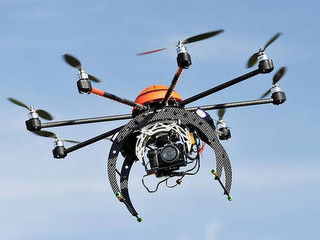M&A activity in the warehouse robotic space
Robots are taking over the heavy lifting work inside warehouses
Read more...
Drones. The thought of a bunch of whizzing rotor blades descending around you as you walk out to your car is scary-dystopian-future terrifying. But drones aren’t just for killing people. (I feel like it’s too early in the week to be saying that.) Commercial drones have a lot of potential uses that can significantly improve lives worldwide.
For example: wildlife conservation. YC graduate Airware sent its team out to the Ol Pejeta Conservancy in Kenya to set up a system of drone surveillance to protect endangered rhinos from poachers. Kenya lost 50 rhinos last year, and the northern white rhino is even scarcer. In 1960, there were more than 2,000 northern white rhinos in existence. Today, there are seven. Those that remain have had their horns removed and are under 24-hour armed protection.
So Airware went to Ol Pejeta, which is the largest black rhino sanctuary in Africa, and set up a drone specifically designed for conservation. The drone, which utilizes Airware’s autopilot platform and control software, picks up real-time video imaging feeds of animals, along with thermal imaging feeds. If poachers are in the area, they’ll be picked up on the camera as well.
The visuals provided by the drone are incomparable. They provide a more expanded picture so Ol Pejeta rangers can get visuals on several miles of land all at once.
And Airware has made the drone easy to use so that rangers need only minimal training to operate it. They can simply configure a flight plan using a mapping interface, launch the drone, and tell it where to point the camera. The drone is completely autonomous from launch to recovery.
In the U.S., one of the things the FAA is concerned about as it figures out how to regulate commercial drones is the issue of loss of communications. God knows we don’t want a bunch of drones spinning out of control above our quiet suburban neighborhoods as we’re just starting our morning cocktail.
Airware has contingency plans for loss of communications.
“Our team was testing flight out of line of sight when a lawn mower ran over a cord to our transmitter causing us to lose communication with the aircraft,” said Airware Flight Director Brian Richman, in a statement. “In the event of a loss of communication, the failsafe designed into our autopilot platform should return the drone home to land autonomously — which is exactly what happened.”
In the first nine months of 2013, venture capitalists invested $41 million in drone technology—all of which went to just three companies: 3D Robotics, which raised $30 million from the Foundry Group, O’Reilly AlphaTech Ventures, SK Ventures, True Ventures, and Mayfield Fund; Airware, which raised $10.7 million from Andreessen Horowitz, Felicis Ventures, First Round Capital, and Google Ventures; and Remotereality Corp., which raised $17,000 from Connecticut Innovations Inc.
While commercial drones haven’t gotten the green light yet in the U.S., they’re already being utilized in other parts of the world. As Mike Winn told Vator earlier this year, farmers in Japan have been using remote control helicopters for crop dusting since the 1990s. DroneDeploy has 250 signups so far and has plans to start work in two countries in Africa.
As the association between drones and warfare becomes less prominent, we’ll likely be seeing a lot more rotor blades in the sky soon.
Robots are taking over the heavy lifting work inside warehouses
Read more...The company also expanded access to 12 different provider types for male fertility care
Read more...Ezra's AI cancer screening platform will be available in 150 RAYUS locations
Read more...
